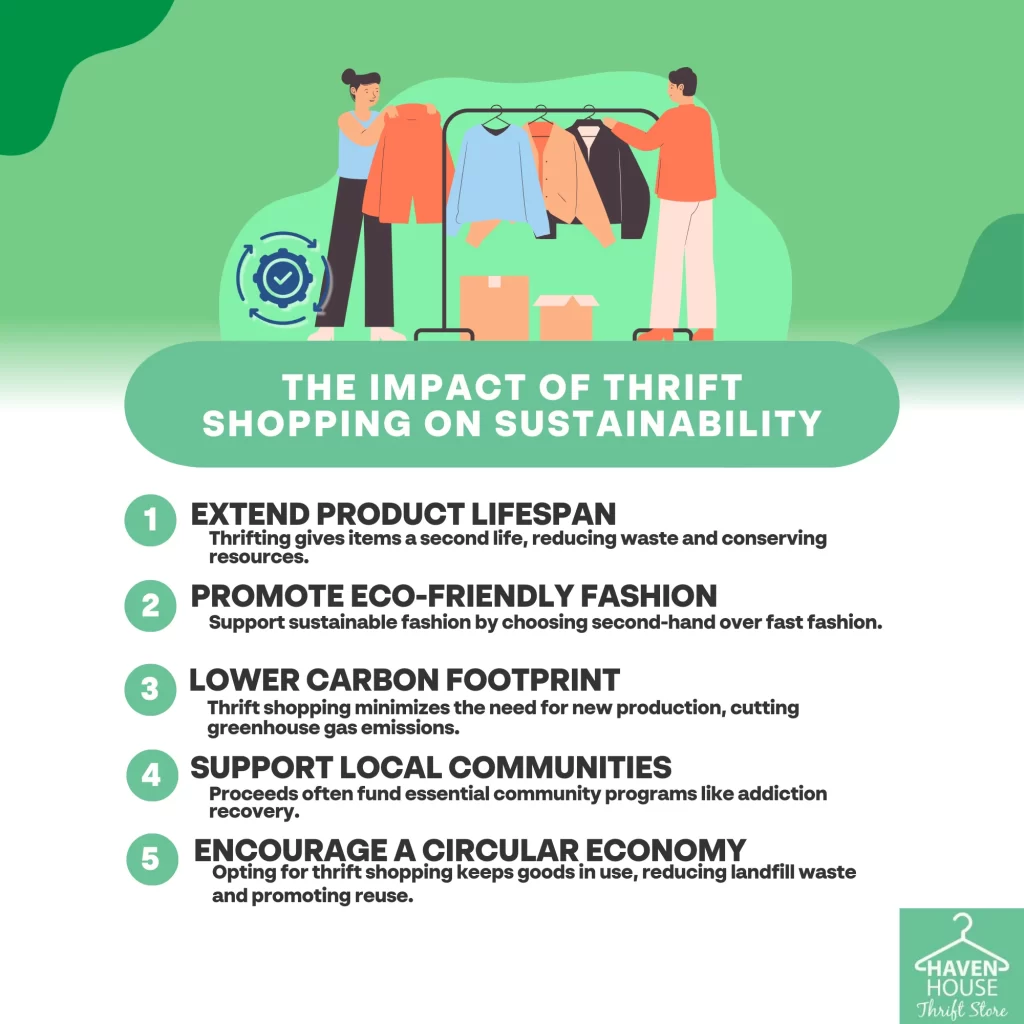Thrifting is a fantastic way to live sustainably, and it can transform your shopping habits. By purchasing second-hand, you reduce textile waste and lower your carbon footprint. You’re not just saving money; you’re also supporting local communities and charities, as thrift store profits often fund essential initiatives. Plus, you help conserve resources by choosing unique items that promote a circular economy instead of fast fashion. This mindful consumption encourages creativity and responsible buying decisions. If you’re curious about even more innovative ways thrift shopping can impact sustainability, there’s a lot more to discover!

Key Takeaways
- Thrifting extends the lifecycle of clothing, promoting reuse and reducing landfill waste, which is essential for a circular economy.
- Shopping second-hand decreases the demand for fast fashion, lowering environmental impact and promoting sustainable consumer habits.
- Unique thrifted items encourage creativity and individual expression while fostering a culture of responsible consumption within the community.
- Profits from thrift stores often support local charities, strengthening community ties and enhancing resilience through sustainable initiatives.
- Thrift shopping minimizes resource consumption and packaging waste, contributing to reduced greenhouse gas emissions and promoting eco-friendly practices.
Reduction in Waste Production
Thrifting is an impactful way to reduce waste production while supporting your community. When you choose to shop at thrift stores, you’re not just finding unique items; you’re actively participating in thrifting sustainability. Every piece of clothing, furniture, or household item you purchase has likely been rescued from a landfill, giving it a second life instead of contributing to the overwhelming waste we generate.
By buying pre-owned goods, you’re helping to minimize the demand for new products, which often come at a high environmental cost. This means fewer resources are consumed, and less pollution is generated in the manufacturing process.
In addition, donating your unwanted items to thrift stores guarantees they get a chance to be reused, further extending their lifespan and reducing waste.
Engaging in thrifting also supports local initiatives. Many thrift stores funnel their proceeds into community programs, helping those in need while fostering a sense of connection.
Conservation of Resources
Choosing to shop at thrift stores is a powerful way to conserve resources and promote sustainability. When you opt for thrifting, you’re not just finding unique pieces; you’re also extending the lifecycle of clothing and goods that might otherwise end up in landfills. By purchasing second-hand items, you help reduce the demand for new products, which often require significant resources for production, such as water, energy, and raw materials.
Moreover, thrifting supports sustainable fashion by prioritizing quality over quantity. You’re likely to find well-made garments that have already stood the test of time, which means you’re investing in durability rather than disposable trends. This shift not only saves you money but also encourages a more mindful approach to consumption.
Additionally, every item you buy from a thrift store contributes to conserving the environment. It minimizes waste and promotes a circular economy, where goods are reused and repurposed.
Lowering Carbon Footprint
Shopping at thrift stores not only helps conserve resources but also plays a crucial role in lowering your carbon footprint. When you choose to buy second-hand items, you effectively reduce the demand for new production, which is often resource-intensive and carbon-heavy. Every piece of clothing or furniture you purchase from a thrift store means one less item manufactured, considerably cutting down on greenhouse gas emissions associated with manufacturing and transportation.
Moreover, thrifting helps the environment by extending the life cycle of products. Instead of ending up in landfills, gently used items find new homes, minimizing waste. This practice not only conserves energy but also reduces harmful emissions generated from decomposing materials.
Additionally, thrift stores often source local donations, which means items don’t have to travel far to reach you. This local aspect further decreases the carbon footprint associated with shipping and logistics.
Promoting Sustainable Consumer Habits
Embracing sustainable consumer habits can considerably impact both your wallet and the planet. By choosing thrift stores, you not only save money but also promote sustainable fashion, helping to reduce waste and pollution.
Here are a few ways you can enhance your sustainable consumer practices:
- Opt for secondhand: Shopping at thrift stores means you’re giving clothes a second life, reducing the demand for new garments and the resources needed to produce them.
- Curate a unique wardrobe: Thrifting allows you to discover one-of-a-kind pieces that reflect your personal style, making your fashion choices more individualistic and less trend-driven.
- Support eco-friendly initiatives: Many thrift stores contribute to local charities and community programs, ensuring that your purchases have a positive impact far beyond your closet.
Supporting Local Communities
By supporting local thrift stores, you play an essential role in strengthening your community while making sustainable choices. When you shop at these stores, you’re not just finding unique pieces; you’re investing in local initiatives that directly benefit your neighborhood. Many thrift shops, like those in Santa Rosa Beach and Destin, funnel their profits into addiction recovery programs, helping individuals rebuild their lives. By opting for sustainable fashion on a budget, you’re also promoting a circular economy. Each purchase you make helps divert items from landfills, reducing waste. Plus, your donations allow these stores to maintain a diverse inventory, ensuring that everyone has access to affordable clothing and household goods. Engaging with local thrift stores fosters a sense of community. You’re not just buying clothes; you’re supporting employment opportunities and community resources. Every transaction contributes to a larger mission of recovery and growth. Thrifting sustainable fashion also has a unique charm and timelessness to it. Sustainable fashion trends have also started to shape the fashion world. Who wants to wear Gucci when you can look dapper in a sustainable way? Sustainability thrifting isn’t just another buzzword, it is a movement that is gaining ground every day while we battle climate change and fight for a cleaner earth. So, when someone you know asks what is sustainable fashion? You can answer why thrifting is good for the environment and become the fashion Guru of your dreams!
Extending Product Lifespan
Extending the life span of products not only benefits your wallet but also contributes greatly to environmental sustainability.
When you thrift shop, you’re choosing to give pre-loved items a second chance at life. This practice helps reduce waste and minimizes the demand for new products, which often require significant resources to produce.
Here are some creative ways you can extend product lifespan through thrift shopping sustainability:
- Repair and recycle: Instead of discarding items, consider repairing or creatively transforming them. A simple fix or a little paint can breathe new life into worn-out goods.
- Mix and Match: Combine thrifted pieces with what you already own. This not only diversifies your wardrobe but also encourages you to maximize your existing items.
- Organize Clothing Swaps: Gather friends for a clothing swap party. This fun gathering can refresh your wardrobe without creating waste, extending the life of clothes even further.
Decreasing Textile Pollution
Thrifting not only helps you give items a second life but also plays a significant role in reducing textile pollution. By choosing pre-loved clothing, you’re actively diverting textiles from landfills, where they can take years to decompose.
The fashion industry is notorious for its waste, contributing to pollution through fast fashion production and disposal. When you shop at thrift stores, you’re embracing sustainable fashion innovations that prioritize recycling and upcycling, which are essential for a healthier planet.
Every piece you purchase is a statement against the harmful practices of mass production. You’re not just saving money; you’re also minimizing your carbon footprint.
Plus, with each thrifted item, you support businesses that often promote sustainable practices themselves. This creates a ripple effect, encouraging others to reflect on their consumption habits.
Reducing Energy Consumption
Embracing thrift shopping can greatly reduce energy consumption, offering a simple yet impactful way to contribute to sustainability.
You might wonder, how does thrifting help the environment? By choosing second-hand items over new ones, you’re directly decreasing the demand for new production, which often involves energy-intensive processes.
Consider these benefits of thrifting:
- Lower Carbon Footprint: Each thrifted item saves energy that would have been used in manufacturing, shipping, and packaging new goods.
- Resource Conservation: Thrifting means fewer raw materials are needed, preserving our planet’s resources and reducing energy consumption in the production cycle.
- Waste Reduction: By purchasing pre-loved items, you help divert waste from landfills, where decomposing materials can release harmful greenhouse gasses.
Encouraging Circular Economy
One way to promote a sustainable future is by participating in a circular economy, where the lifecycle of products is extended through reuse and recycling. Thrifting plays a pivotal role here.
When you choose to shop at thrift stores, you’re not just finding unique items; you’re also embracing sustainable fashion meaning. This approach minimizes waste by giving pre-loved items a new home instead of letting them end up in landfills.
When you buy second-hand, you support a system that values longevity over disposability. Each purchase you make encourages brands to rethink their production processes and consider more sustainable materials.
By engaging in thrifting, you help create demand for a fashion industry that prioritizes environmental impact.
Moreover, donating your own items keeps the cycle going. It guarantees that your clothes and goods can be reused, further reducing the need for new production.
This active participation contributes to a healthier planet and promotes a community spirit. By choosing thrifting, you’re not just making a fashion statement; you’re fostering an economy that values sustainability, responsibility, and creativity.
Minimizing Packaging Waste
Reducing packaging waste is a crucial step toward a more sustainable lifestyle, and thrifting offers a fantastic solution. By choosing second-hand items, you’re not only saving money but also minimizing the amount of new packaging produced. Each thrifted item comes with its own history and story, and you can feel good knowing you’re contributing to sustainability efforts.
Here are three ways thrifting helps reduce packaging waste:
- Less New Packaging: When you buy second-hand, you’re avoiding the single-use packaging that often accompanies new products.
- Reusing and Recycling: Thrift stores often repurpose items, giving them a new life without the need for additional packaging.
- Community Impact: Your purchases support local charities, which often prioritize eco-friendly practices, further reducing waste.
Frequently Asked Questions
How Do Thrift Stores Support Local Addiction Recovery Programs?
Thrift stores support local addiction recovery programs by processing donations and selling affordable items. Your purchases directly fund essential recovery services, helping individuals rebuild their lives and fostering community engagement through your active participation.
Where Can I Find Thrift Stores in My Area?
You can find thrift stores in various locations, like Santa Rosa Beach, Destin, Panama City Beach, Lebanon, and Carthage. Each store offers unique items while supporting local community initiatives and recovery programs. Check them out!
What Types of Items Can I Donate to Thrift Stores?
You can donate gently used clothing, household items, books, toys, and furniture to thrift stores. Your contributions not only declutter your space but also support local charities and make a positive impact in your community.
How Do Thrift Store Sales Impact Community Initiatives?
Did you know that every $1 spent at thrift stores can generate up to $3 for local charities? By shopping and donating, you’re directly supporting community initiatives and helping individuals in need transform their lives.
Can I Volunteer at My Local Thrift Store?
Yes, you can definitely volunteer at your local thrift store! It’s a great way to support community initiatives, meet new people, and make a positive impact. Just contact the store to find out how you can help.
Conclusion
By embracing thrifting, you’re not just finding hidden gems; you’re planting seeds of change in a garden of sustainability. Each item you rescue symbolizes a commitment to reducing waste and supporting local communities. As you curate your wardrobe and home, you cultivate a lifestyle that values resources and promotes a circular economy. So, let your thrifted treasures be more than just possessions—let them be reminders that conscious choices can bloom into a brighter, greener future for us all. When we post the question “how thrifting can help the environment?” we should be reminded that it is easy to discard things it takes a keen eye to reshape the clothes of the past into trend-setting masterpieces!

